trailer Hyundai Grandeur 2002 Owner's Manual
[x] Cancel search | Manufacturer: HYUNDAI, Model Year: 2002, Model line: Grandeur, Model: Hyundai Grandeur 2002Pages: 230, PDF Size: 3.82 MB
Page 16 of 230
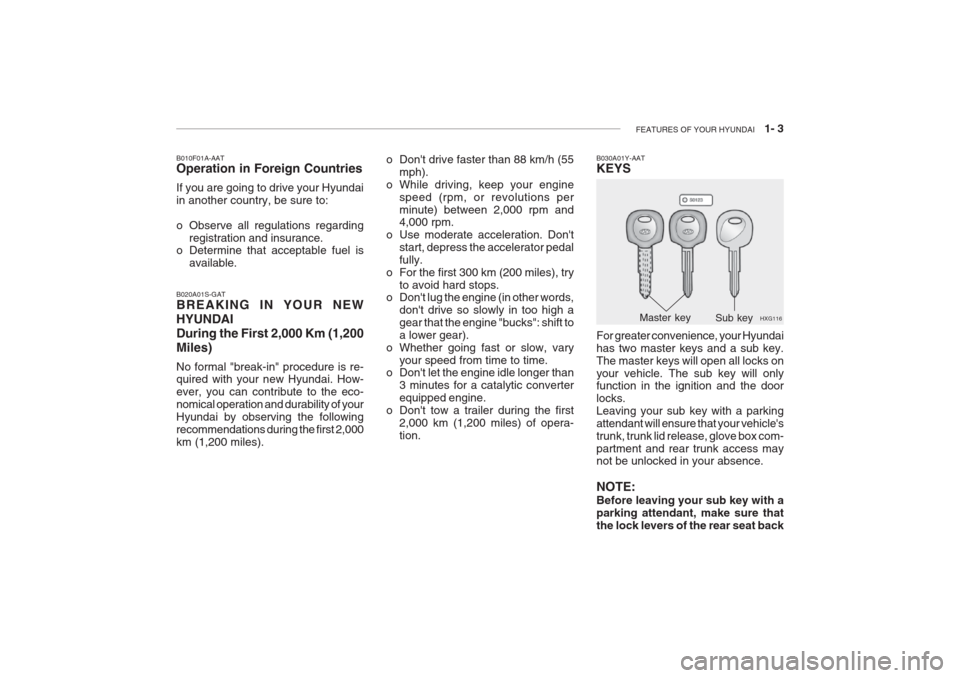
FEATURES OF YOUR HYUNDAI 1- 3
B010F01A-AAT Operation in Foreign Countries If you are going to drive your Hyundai in another country, be sure to:
o Observe all regulations regarding
registration and insurance.
o Determine that acceptable fuel is
available.
B020A01S-GAT BREAKING IN YOUR NEW HYUNDAIDuring the First 2,000 Km (1,200Miles) No formal "break-in" procedure is re- quired with your new Hyundai. How- ever, you can contribute to the eco-nomical operation and durability of yourHyundai by observing the followingrecommendations during the first 2,000km (1,200 miles). B030A01Y-AAT KEYS For greater convenience, your Hyundai has two master keys and a sub key.The master keys will open all locks onyour vehicle. The sub key will only function in the ignition and the door locks.Leaving your sub key with a parkingattendant will ensure that your vehicle'strunk, trunk lid release, glove box com-partment and rear trunk access may not be unlocked in your absence. NOTE: Before leaving your sub key with a parking attendant, make sure thatthe lock levers of the rear seat back
HXG116
Master key Sub key
o Don't drive faster than 88 km/h (55
mph).
o While driving, keep your engine speed (rpm, or revolutions per minute) between 2,000 rpm and 4,000 rpm.
o Use moderate acceleration. Don't start, depress the accelerator pedal fully.
o For the first 300 km (200 miles), try to avoid hard stops.
o Don't lug the engine (in other words,
don't drive so slowly in too high agear that the engine "bucks": shift toa lower gear).
o Whether going fast or slow, vary
your speed from time to time.
o Don't let the engine idle longer than
3 minutes for a catalytic converterequipped engine.
o Don't tow a trailer during the first 2,000 km (1,200 miles) of opera-tion.
Page 85 of 230
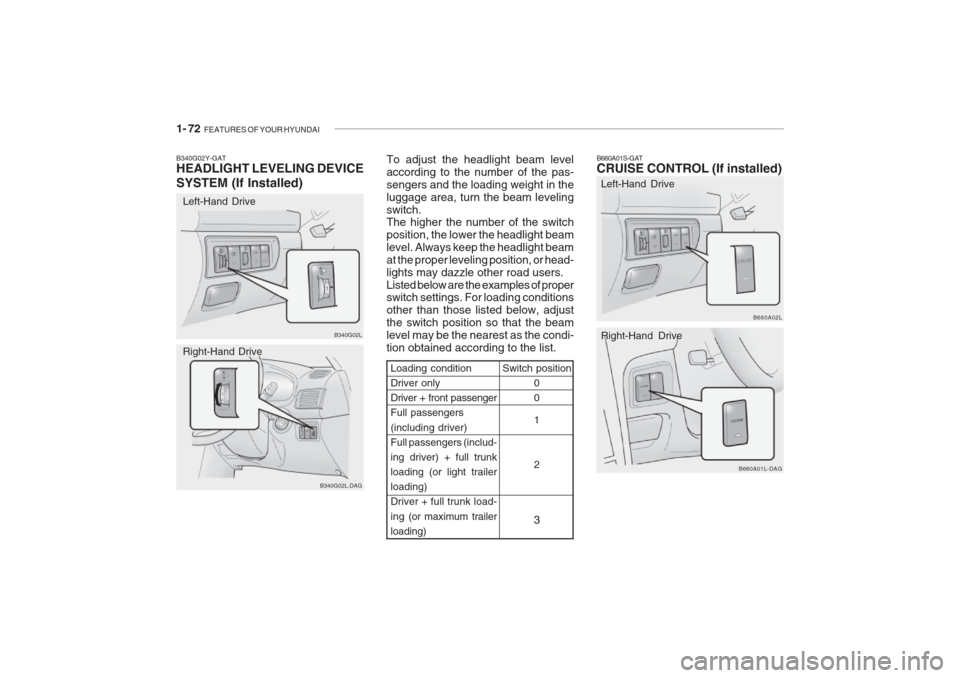
1- 72 FEATURES OF YOUR HYUNDAI
B660A01S-GAT CRUISE CONTROL (If installed)
B660A02L
B660A01L-DAG
Left-Hand Drive Right-Hand Drive
Switch position
0 0 1 2
3Loading condition Driver onlyDriver + front passengerFull passengers (including driver) Full passengers (includ-ing driver) + full trunkloading (or light trailerloading)
Driver + full trunk load- ing (or maximum trailer
loading)
B340G02L
B340G02L.DAG
B340G02Y-GAT HEADLIGHT LEVELING DEVICE
SYSTEM (If Installed)
Left-Hand Drive Right-Hand Drive
To adjust the headlight beam level according to the number of the pas-sengers and the loading weight in theluggage area, turn the beam levelingswitch. The higher the number of the switch position, the lower the headlight beamlevel. Always keep the headlight beamat the proper leveling position, or head-lights may dazzle other road users.Listed below are the examples of proper switch settings. For loading conditions other than those listed below, adjustthe switch position so that the beamlevel may be the nearest as the condi-tion obtained according to the list.
Page 130 of 230
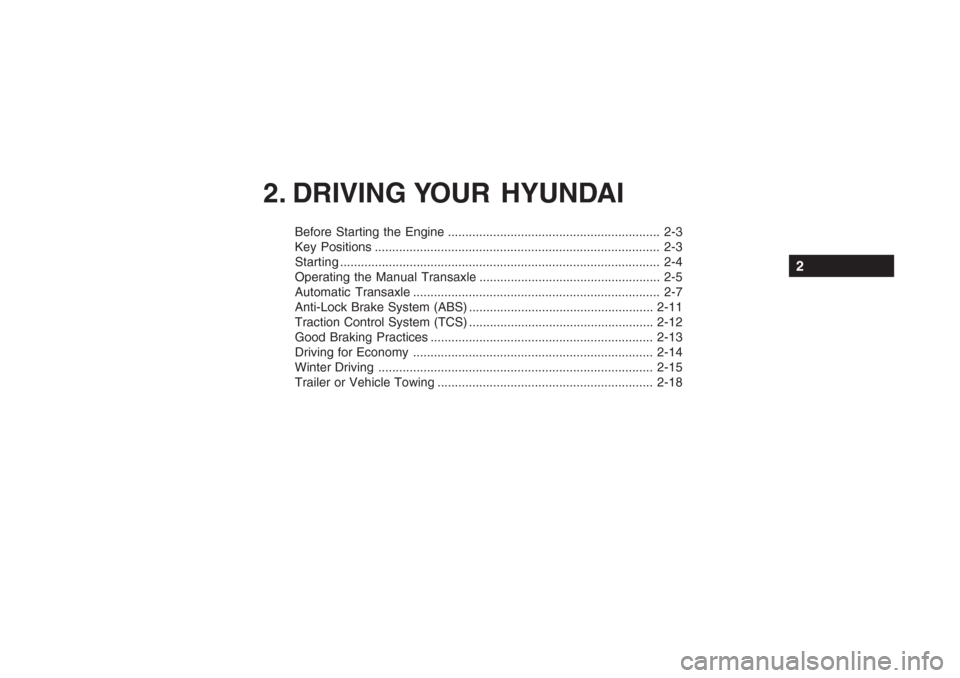
2. DRIVING YOUR HYUNDAI
Before Starting the Engine ............................................................. 2-3
Key Positions .................................................................................. 2-3Starting............................................................................................ 2-4
Operating the Manual Transaxle .................................................... 2-5
Automatic Transaxle ....................................................................... 2-7Anti-Lock Brake System ( ABS) .................................................... . 2-11
Traction Control System (TCS) ..................................................... 2-12
Good Braking Practices ................................................................ 2-13
Driving for Economy ..................................................................... 2-14
Winter Driving ............................................................................... 2-15
Trailer or Vehicle Towing .............................................................. 2-18
2
Page 147 of 230
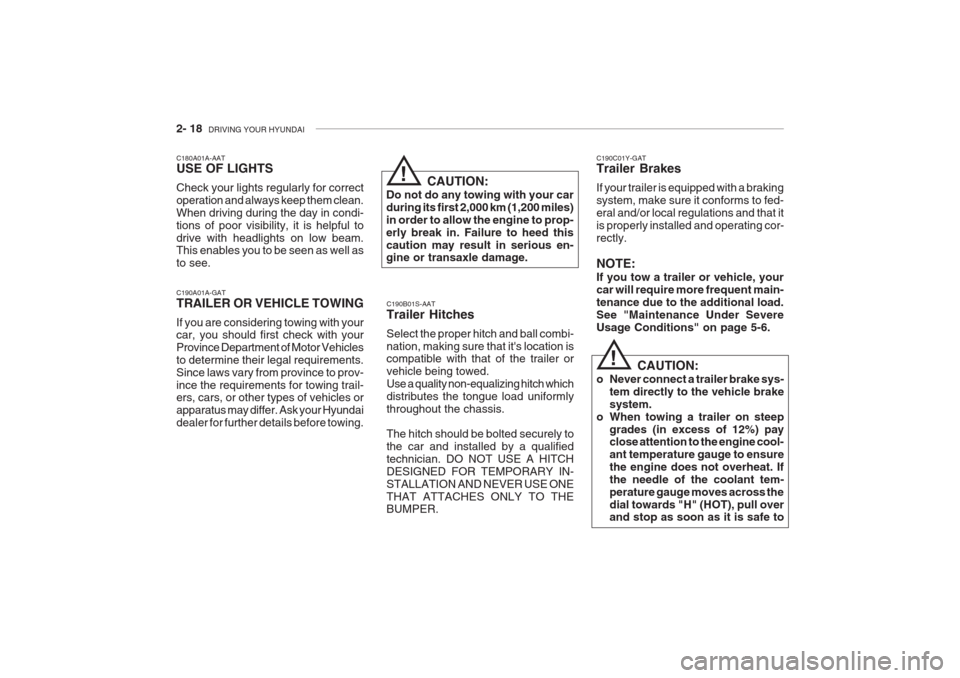
2- 18 DRIVING YOUR HYUNDAI
C190C01Y-GAT Trailer Brakes If your trailer is equipped with a braking system, make sure it conforms to fed-eral and/or local regulations and that it
is properly installed and operating cor-rectly. NOTE: If you tow a trailer or vehicle, your car will require more frequent main-tenance due to the additional load.See "Maintenance Under SevereUsage Conditions" on page 5-6.
CAUTION:
o Never connect a trailer brake sys- tem directly to the vehicle brakesystem.
o When towing a trailer on steep grades (in excess of 12%) pay
close attention to the engine cool- ant temperature gauge to ensure
the engine does not overheat. Ifthe needle of the coolant tem-
perature gauge moves across thedial towards "H" (HOT), pull over and stop as soon as it is safe to
C190B01S-AATTrailer Hitches Select the proper hitch and ball combi- nation, making sure that it's location is compatible with that of the trailer or vehicle being towed.Use a quality non-equalizing hitch whichdistributes the tongue load uniformlythroughout the chassis. The hitch should be bolted securely to the car and installed by a qualifiedtechnician. DO NOT USE A HITCHDESIGNED FOR TEMPORARY IN-STALLATION AND NEVER USE ONETHAT ATTACHES ONLY TO THE BUMPER.
C180A01A-AAT USE OF LIGHTS Check your lights regularly for correct operation and always keep them clean.When driving during the day in condi-tions of poor visibility, it is helpful todrive with headlights on low beam. This enables you to be seen as well as to see. C190A01A-GAT TRAILER OR VEHICLE TOWING If you are considering towing with your car, you should first check with your Province Department of Motor Vehiclesto determine their legal requirements.Since laws vary from province to prov-ince the requirements for towing trail- ers, cars, or other types of vehicles or apparatus may differ. Ask your Hyundaidealer for further details before towing.
CAUTION:
Do not do any towing with your carduring its first 2,000 km (1,200 miles)in order to allow the engine to prop-erly break in. Failure to heed thiscaution may result in serious en- gine or transaxle damage.
!
!
Page 148 of 230
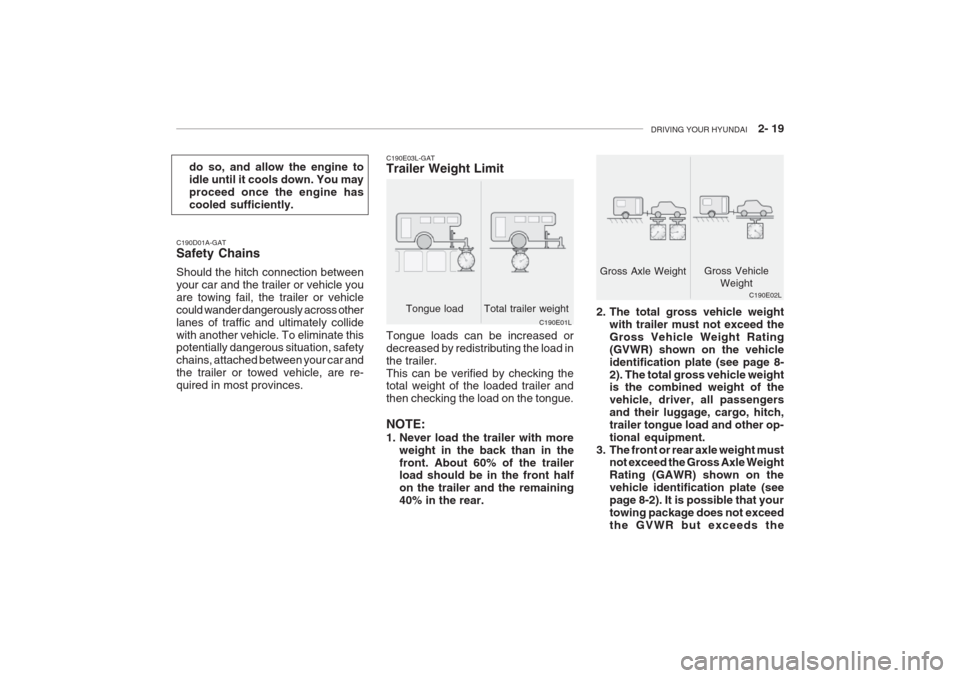
DRIVING YOUR HYUNDAI 2- 19
C190E03L-GAT Trailer Weight Limit
Tongue load Total trailer weight C190E01L2. The total gross vehicle weight
with trailer must not exceed the Gross Vehicle Weight Rating(GVWR) shown on the vehicleidentification plate (see page 8-2). The total gross vehicle weight is the combined weight of the vehicle, driver, all passengersand their luggage, cargo, hitch,
trailer tongue load and other op-tional equipment.
3. The front or rear axle weight must not exceed the Gross Axle Weight
Rating (GAWR) shown on thevehicle identification plate (seepage 8-2). It is possible that yourtowing package does not exceedthe GVWR but exceeds the
C190D01A-GAT Safety Chains Should the hitch connection between your car and the trailer or vehicle youare towing fail, the trailer or vehiclecould wander dangerously across otherlanes of traffic and ultimately collidewith another vehicle. To eliminate this potentially dangerous situation, safety chains, attached between your car andthe trailer or towed vehicle, are re-quired in most provinces.
Tongue loads can be increased ordecreased by redistributing the load inthe trailer.This can be verified by checking the total weight of the loaded trailer and then checking the load on the tongue. NOTE:
1. Never load the trailer with more
weight in the back than in the front. About 60% of the trailer load should be in the front half on the trailer and the remaining40% in the rear.
do so, and allow the engine toidle until it cools down. You may
proceed once the engine hascooled sufficiently.
C190E02L
Gross Axle Weight
Gross Vehicle
Weight
Page 149 of 230
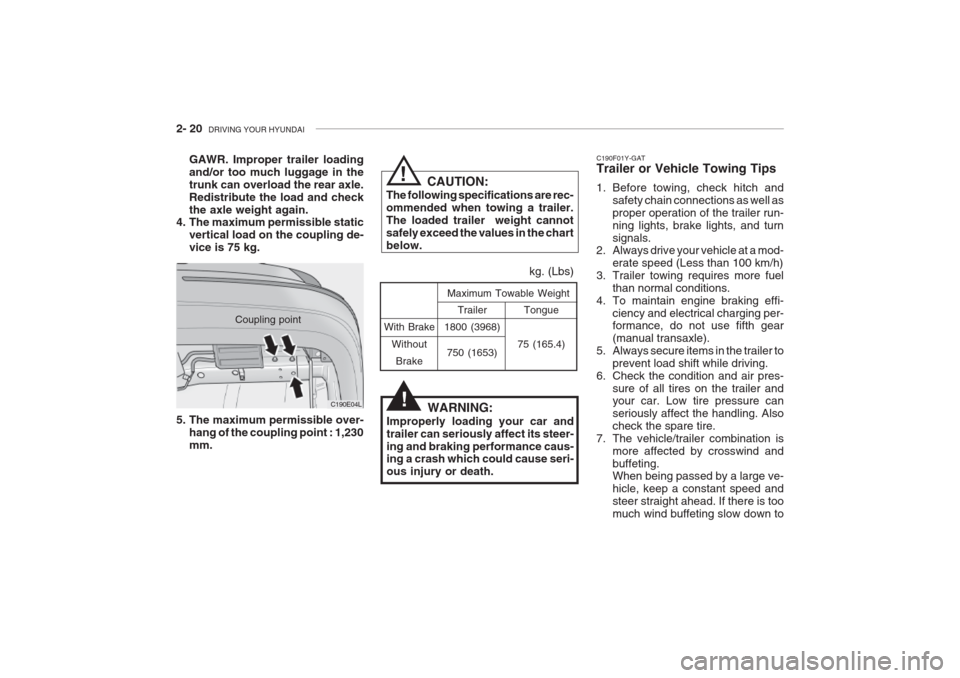
2- 20 DRIVING YOUR HYUNDAI
With Brake
WithoutBrake Tongue
75 (165.4)
Maximum Towable Weight
kg. (Lbs)
Trailer
1800 (3968)
750 (1653)
WARNING:
Improperly loading your car and trailer can seriously affect its steer-ing and braking performance caus- ing a crash which could cause seri- ous injury or death. C190F01Y-GAT Trailer or Vehicle Towing Tips
1. Before towing, check hitch and
safety chain connections as well as proper operation of the trailer run-ning lights, brake lights, and turnsignals.
2. Always drive your vehicle at a mod-
erate speed (Less than 100 km/h)
3. Trailer towing requires more fuel
than normal conditions.
4. To maintain engine braking effi-
ciency and electrical charging per- formance, do not use fifth gear (manual transaxle).
5. Always secure items in the trailer to prevent load shift while driving.
6. Check the condition and air pres-
sure of all tires on the trailer and your car. Low tire pressure can seriously affect the handling. Alsocheck the spare tire.
7. The vehicle/trailer combination is more affected by crosswind andbuffeting. When being passed by a large ve- hicle, keep a constant speed andsteer straight ahead. If there is toomuch wind buffeting slow down to
Coupling point
C190E04L
GAWR. Improper trailer loadingand/or too much luggage in thetrunk can overload the rear axle.Redistribute the load and checkthe axle weight again.
4. The maximum permissible static
vertical load on the coupling de-vice is 75 kg. CAUTION:
The following specifications are rec-ommended when towing a trailer.The loaded trailer weight cannotsafely exceed the values in the chartbelow.
!
!
5. The maximum permissible over- hang of the coupling point : 1,230 mm.
Page 150 of 230
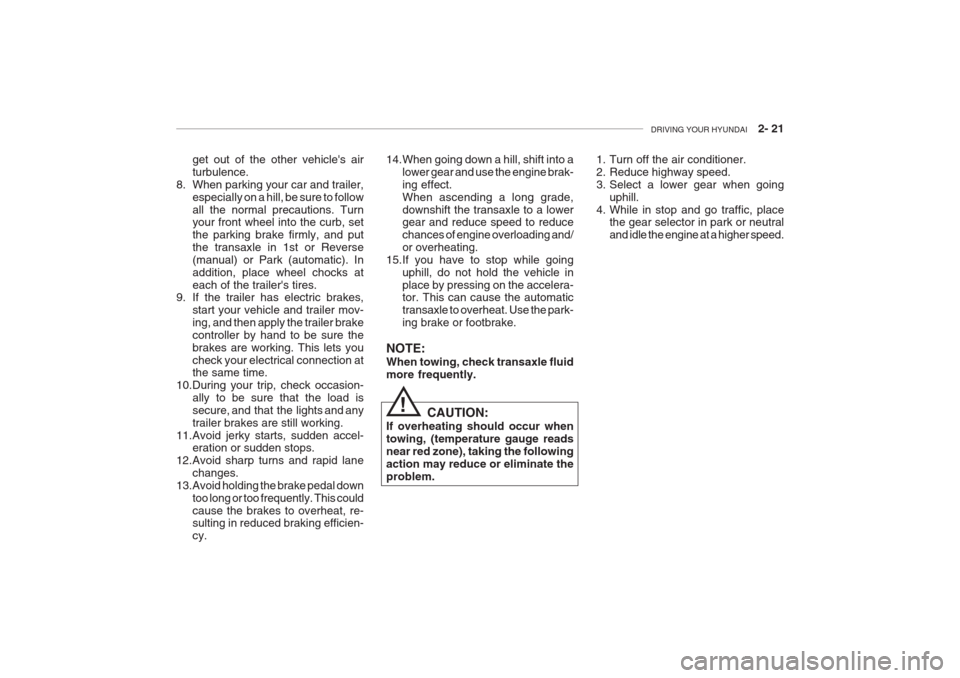
DRIVING YOUR HYUNDAI 2- 21
14.When going down a hill, shift into a
lower gear and use the engine brak- ing effect.When ascending a long grade,downshift the transaxle to a lower gear and reduce speed to reduce chances of engine overloading and/or overheating.
15.If you have to stop while going uphill, do not hold the vehicle inplace by pressing on the accelera- tor. This can cause the automatic transaxle to overheat. Use the park-ing brake or footbrake.
NOTE: When towing, check transaxle fluid more frequently.
CAUTION:
If overheating should occur whentowing, (temperature gauge readsnear red zone), taking the followingaction may reduce or eliminate theproblem.
get out of the other vehicle's airturbulence.
8. When parking your car and trailer,
especially on a hill, be sure to followall the normal precautions. Turn your front wheel into the curb, set the parking brake firmly, and putthe transaxle in 1st or Reverse(manual) or Park (automatic). Inaddition, place wheel chocks ateach of the trailer's tires.
9. If the trailer has electric brakes,
start your vehicle and trailer mov-ing, and then apply the trailer brakecontroller by hand to be sure thebrakes are working. This lets youcheck your electrical connection at the same time.
10.During your trip, check occasion- ally to be sure that the load is secure, and that the lights and anytrailer brakes are still working.
11.Avoid jerky starts, sudden accel- eration or sudden stops.
12.Avoid sharp turns and rapid lane changes.
13.Avoid holding the brake pedal down too long or too frequently. This couldcause the brakes to overheat, re- sulting in reduced braking efficien- cy. 1. Turn off the air conditioner.
2. Reduce highway speed.
3. Select a lower gear when going
uphill.
4. While in stop and go traffic, place the gear selector in park or neutraland idle the engine at a higher speed.
!
Page 174 of 230

5- 6 VEHICLE MAINTENANCE REQUIREMENTS
ENGINE OIL AND FILTER AIR CLEANER FILTERSPARK PLUGSTIMING BELTBRAKE PADS, CALIPERS AND ROTORSREAR BRAKE DRUMS/LININGS,PARKING BRAKE
STEERING GEAR BOX, LINKAGE& BOOTS/LOWER ARM BALL JOINT,UPPER ARM BALL JOINTDRIVESHAFTS & BOOTSMANUAL TRANSAXLE OILAUTOMATIC TRANSA-XLE FLUID AND FILTERAIR FILTER (FOR EVAP. AND BLOWER UNIT) European Community OnlyExcept European Community
F040A03L-GAT MAINTENANCE UNDER SEVERE USAGE CONDITIONS The following items must be serviced more frequently on cars normally used under severe driving conditions. Refer to the chart below for the appropriate maintenance intervals. R : Replace I : Inspect and, after inspection, clean, adjust, repair or replace if necessaryR RRR
I I I I
RRREVERY 7,500 KM OR 6 MONTHS MORE FREQUENTLYMORE FREQUENTLYEVERY 60,000 KM OR 48 MONTHSMORE FREQUENTLY MORE FREQUENTLY MORE FREQUENTLY EVERY 15,000 KM OR 12 MONTHS EVERY 100,000 KMEVERY 45,000 KMEVERY 40,000 KMMORE FREQUENTLY
SEVERE DRIVING CONDITIONS
A - Repeated short distance driving
B - Extensive idling
C - Driving in dusty, rough roads
D - Driving in areas using salt or other corrosive materials or in very cold weather
E - Driving in sandy areas
A, B, C, F, H C, EB, HD, E, F, GC, D, G, H C, D, G, H C, D, E, F C, D, E, F A, C, D, E, F, G, H, I, J A, C, E, F, G, H, I, JC, E DRIVING
CONDITION
MAINTENANCE INTERVALS
MAINTENANCE
OPERATION
MAINTENANCE ITEM
F - More than 50% driving in heavy city traffic during hot weatherabove 32°C (90°F)
G - Driving in mountainous areas
H - Towing a trailer
I - Driving as a patrol car, taxi, vehicle towing or other
commercial use
J - Driving over 170 Km/h (100 MPH)
Page 229 of 230
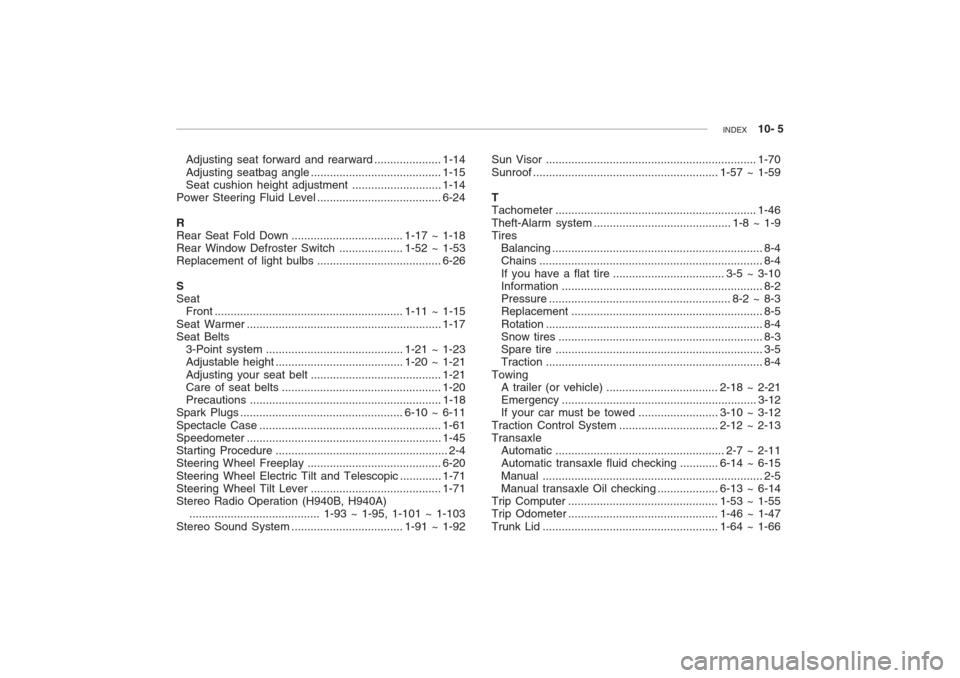
INDEX 10- 5
Adjusting seat forward and rear ward..................... 1-14
Adjusting seatbag angle ......................................... 1-15 Seat cushion height adjustment............................ 1-14
Power Steering Fluid Level ....................................... 6-24 R
Rear Seat Fold Down ................................... 1-17 ~ 1-18Rear Window Defroster Switch .................... 1-52 ~ 1-53
Replacement of light bulbs ....................................... 6-26 S Seat Front ........................................................... 1-11 ~ 1-15
Seat Warmer ............................................................. 1-17
Seat Belts
3-Point system ........................................... 1-21 ~ 1-23
Adjustable height ........................................ 1-20 ~ 1-21
Adjusting your seat belt ......................................... 1-21Care of seat belts .................................................. 1-20
Precautions ............................................................ 1-18
Spark Plugs ................................................... 6-10 ~ 6-11
Spectacle Case ......................................................... 1-61
Speedometer ............................................................. 1-45
Starting Procedure ...................................................... 2-4
Steering Wheel Freeplay .......................................... 6-20
Steering Wheel Electric T ilt and Telescopic ............. 1-71
Steering Wheel Tilt Lever ......................................... 1-71 Stereo Radio Operation (H940B, H940A)
......................................... 1-93 ~ 1-95, 1-101 ~ 1-103
Stereo Sound System ................................... 1-91 ~ 1-92 Sun Visor
.................................................................. 1-70
Sunroof .......................................................... 1-57 ~ 1-59 T
Tachometer ............................................................... 1-46 Theft-Alarm system ........................................... 1-8 ~ 1-9
Tires Balancing .................................................................. 8-4
Chains ...................................................................... 8-4
If you have a flat tire ................................... 3-5 ~ 3-10
Information ............................................................... 8-2
Pressure ......................................................... 8-2 ~ 8-3Replacement ............................................................ 8-5
Rotation .................................................................... 8-4
Snow tires ................................................................ 8-3
Spare tire ................................................................. 3-5
Traction .................................................................... 8-4
Towing A trailer (or vehicle) ................................... 2-18 ~ 2-21
Emergency ............................................................. 3-12
If your car must be towed ......................... 3-10 ~ 3-12
Traction Control System ............................... 2-12 ~ 2-13
Transaxle
Automatic ..................................................... 2-7 ~ 2-11Automatic transaxle fluid checking ............ 6-14 ~ 6-15
Manual ..................................................................... 2-5
Manual transaxle Oil checkin g ................... 6-13 ~ 6-14
Trip Computer ............................................... 1-53 ~ 1-55
Trip Odometer ............................................... 1-46 ~ 1-47
Trunk Lid ....................................................... 1-64 ~ 1-66